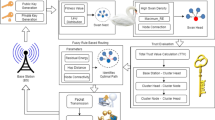Abstract
In this paper a new protocol using fuzzy logic control has been proposed. The protocol is based on Stable Election Protocol (SEP). Fuzzy logic control based on three variables, distance of nodes form base station, density of nodes and the battery level of nodes along with the traditional threshold values used in SEP are used to enhance the process of cluster head election in the existing SEP protocol and improve the lifetime and throughput of the Wireless Sensor Network. The result of the simulation which has been done in MATLAB simulator indicates that Stable Election Protocol based on fuzzy logic is more energy efficient and improves the lifetime and throughput of the network by 73.2 and 68.54 % respectively comparing with the existing SEP protocol.






Similar content being viewed by others
References
Sheng, Z., et al. (2013). A survey on the ietf protocol suite for the internet of things: Standards, challenges, and opportunities. Wireless Communications, IEEE, 20(6), 91–98.
Peng, L., et al. (2012). CodePipe: An opportunistic feeding and routing protocol for reliable multicast with pipelined network coding. In INFOCOM, 2012 Proceedings IEEE (pp. 100–108). doi:10.1109/INFCOM.2012.6195456.
Chilamkurti, N., et al. (2009). Cross-layer support for energy efficient routing in wireless sensor networks. Journal of Sensors, 2009, 9. doi:10.1155/2009/134165.
Liu, Y., et al. (2010). Multi-layer clustering routing algorithm for wireless vehicular sensor networks. IET Communications, 4(7), 810–816.
Li, Peng, Guo, Song, Shui, Yu., & Vasilakos, Athanasios V. (2014). Reliable multicast with pipelined network coding using opportunistic feeding and routing. IEEE Transactions on Parallel and Distributed Systems, 25(12), 3264–3273.
Zeng, Yuanyuan, et al. (2013). Directional routing and scheduling for green vehicular delay tolerant networks. Wireless Networks, 19(2), 161–173.
Heinzelman, W. B., Chandrakasan, A. P., Balakrishnan, H., et al. (2002). An application-specific protocol architecture for wireless microsensor networks. IEEE Transactions on Wireless Communications, 1(4), 660–670.
Al-Karak, J. N., & Kamal, A. E. (2004). Routing techniques in wireless sensor network: A survey. IEEE Wireless Communications, 11, 6–28.
Lindsey, S., Raghavendra, C., & Sivalingam, K. M. (2002). Data gathering algorithms in sensor networks using energy metrics. IEEE Transactions on Parallel and Distributed Systems, 13(9), 924–935.
Smaragdakis, G., Matta, I., & Bestavros, A. (2004). Sep: A stable election protocol for clustered heterogeneous wireless sensor networks. Tech. Rep.: Boston University Computer Science Department.
Aderohunmu, F. A., & Deng, J. D. (2010). An enhanced stable election protocol (sep) for clustered heterogeneous wsn. In XH Wu, S. Wang (Eds.), Performance comparison of LEACH and LEACH-C C protocols by NS2, Proceedings of 9th International Symposium on Distributed Computing and Applications to Business, Engineering and Science. Hong Kong, China, 2010, pp. 254–258.
Xiang, Liu, & Luo, Jun. (2011). Athanasios V (pp. 46–54). Vasilakos: Compressed data aggregation for energy efficient wireless sensor networks. SECON.
Wei, Guiyi, et al. (2011). Prediction-based data aggregation in wireless sensor networks: Combining grey model and Kalman Filter. Computer Communications, 34(6), 793–802.
Yanjun Yao, et al: EDAL: An energy-efficient, delay-aware, and lifetime-balancing data collection protocol for wireless sensor networks. MASS 2013: 182–190.
Liu, X.-Y., et al. (2014). CDC: compressive data collection for wireless sensor networks. IEEE Transactions on Parallel & Distributed Systems. doi:10.1109/TPDS.2014.2345257.
Yao, Y., et al. (2014). EDAL: An energy-efficient, delay-aware, and lifetime-balancing data collection protocol for heterogeneous wireless sensor networks. IEEE/ACM Transactions on Networking, 23(3), 1063–6692. doi:10.1109/TNET.2014.2306592.
Song, Yuning, et al. (2014). A biology-based algorithm to minimal exposure problem of wireless sensor networks. IEEE Transactions on Network and Service Management, 11(3), 417–430.
Sengupta, Soumyadip, et al. (2012). An evolutionary multiobjective sleep-scheduling scheme for differentiated coverage in wireless sensor networks. IEEE Transactions on Systems, Man, and Cybernetics, Part C, 42(6), 1093–1102.
Li, Mo, et al. (2013). A survey on topology control in wireless sensor networks: taxonomy, comparative study, and open issues. Proceedings of the IEEE, 101(12), 2538–2557.
Liu, L., et al. (2015). Physarum optimization: a biology-inspired algorithm for the steiner tree problem in networks. IEEE Transactions on Computers, 64(3), 819–832.
Kai, H., et al. (2013). Algorithm design for data communications in duty-cycled wireless sensor networks: A survey. IEEE Communications Magazine, 51(7), 107–113. doi:10.1109/MCOM.2013.6553686.
Youssef, M., et al. (2014). Routing metrics of cognitive radio networks: A survey. IEEE Communications Surveys and Tutorials, 16(1), 92–109.
Vasilakos, A., et al. (2012). Delay tolerant networks: Protocols and applications. Boca Raton: CRC Press.
Meng, Tong, et al. (2015). Spatial reusability-aware routing in multi-hop wireless networks. IEEE TMC. doi:10.1109/TC.2015.2417543.
Jain, N., Madathil, D, & Agrawal, D. (2003). Energy Aware Multi Path Routing for Uniform Resource Utilization in Sensor Networks. In Proceedings of international workshop on information processing in sensor networks (IPSN’03), California, pp. 392–404.
Vasilakos et al (1998) Evolutionary-fuzzy prediction for strategic QoS routing in broadband networks. In The 1998 IEEE international conference on fuzzy systems proceedings, Vol. 2, pp. 1488–1493.
Gupta, I, Riordan, D, & Sampalli, S. (2005). Cluster-head election using fuzzy logic for wireless sensor networks. In Communication networks and services research conference, 2005. Proceedings of the 3rd Annual. IEEE, pp. 255–260
Myoung Kim, J., Park, S., Han, Y., & Chung, T. (2008) CHEF: cluster head election mechanism using fuzzy logic in wireless sensor networks. In 10th International Conference on Advanced Communication Technology (ICACT), pp. 654–659.
Shen, Y., & Ju, H. (2011) Energy-efficient cluster-head selection based on a fuzzy expert system in wireless sensor networks. In Green Computing and Communications (GreenCom), 2011 IEEE/ACM International Conference on. IEEE, 2011, pp. 110–113.
Author information
Authors and Affiliations
Corresponding author
Rights and permissions
About this article
Cite this article
Tamandani, Y.K., Bokhari, M.U. SEPFL routing protocol based on fuzzy logic control to extend the lifetime and throughput of the wireless sensor network. Wireless Netw 22, 647–653 (2016). https://doi.org/10.1007/s11276-015-0997-x
Published:
Issue Date:
DOI: https://doi.org/10.1007/s11276-015-0997-x




